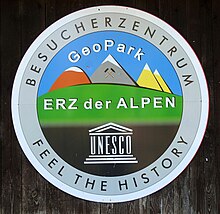Ore Geopark of the Alps
The Geopark Erz der Alpen , also UNESCO Geopark Erz der Alpen or "Erz der Alpen" UNESCO Global Geopark , is on the one hand a scientifically supported, tourism-related project to promote tourism in the state of Salzburg , which aims to position the Pongau more strongly as a former mining area . On the other hand, the region should also be made aware of as a nationally significant geological heritage. Show mines and museums as well as natural sights are advertised. The municipalities and tourism associations of Bischofshofen , Hüttau , Mühlbach am Hochkönig and St. Veit im Pongau are involved . The Erz der Alpen Geopark is currently one of four such Geoparks in Austria (there are also the Styrian Eisenwurzen , Karawanken and Carnic Alps Geoparks ) .
The Geopark has an area of 211 km² and is mostly located in the Grauwackenzone ( Salzburg Slate Alps ) and has a share in the peripheral areas of the Northern Limestone Alps ( Berchtesgaden Alps ) in the north and the Central Alps ( Hohe Tauern ) in the south.
development
As early as 1995, the idea was introduced to combine the region's mining, which dates back to prehistoric times, with other tourist attractions. As a result, the Erz der Alpen association was formed , which continued to operate the matter. After investments in infrastructure were made at the beginning of the 2010s, the Geopark was finally entered in 2014 on the list of international UNESCO Geoparks that are UNESCO World Heritage Sites but are not a protected area.
In April 2015 a visitor center was opened in Bischofshofen at the Paul-Ausserleitner-Schanze . At the opening there was a special exhibition on the Nebra Sky Disc , the metal of which was extracted from a nearby mine in what is now Mühlbach am Hochkönig. A themed hiking trail has also been set up, the copper ore trail in the area of the participating communities. The construction costs should have totaled around 1 million euros. The contributing tourism association Bischofshofen raised around 300,000 euros for this in the years 2011 to 2014.
Advertised objects
The following institutions are advertised in the media:
- Visitor Center (Bischofshofen)
- Show mines and museums
- Larzenbach show mine (Hüttau)
- Sunnpau show mine (St. Veit im Pongau)
- Mühlbach exhibition tunnel (Johanna-Stollen) (Mühlbach am Hochkönig)
- Mine Lehen (Bischofshofen)
- Keltenloch (Mühlbach am Hochkönig)
- Museum ore, gold, minerals (Hüttau)
- Seelacken Museum (St. Veit im Pongau)
- Copper ore route
- The themed path ("Geotrail"), known as the copper ore path, consists of five walking stages, each with a connection to the public transport network and accommodation. It leads from St. Veit to Mühlbach, from Mühlbach to Arthurhaus am Hochkönig, from Arthurhaus to Bischofshofen, from Bischofshofen to the Hochgründeck (Heinrich-Kiener-Haus), and finally from Hochgründeck to Hüttau. The signposted route, which is provided with information boards, connects the advertised mines and museums with popular mountain routes. There is also a Mühlbacher Erzweg (also Mitterberger Erzweg ) in Mühlbach am Hochkönig and a waterfall path in Bischofshofen, which are referred to as part of the ore path.
- Peculiarities of nature
- In addition, the application points out the beauty of nature and, in connection with the geological explanation of the mining region, special features such as the Liechtenstein Gorge in St. Johann or the Gainbach Falls in Bischofshofen are advertised.
There is also a range of guided tours for visitors.
Web links
Individual evidence
- ^ Geopark ore of the Alps. Retrieved July 3, 2020 .
- ↑ As stated in the Salzburgwiki , article UNESCO Geopark Erz der Alpen (version of June 30, 2020) ; the sources there are no longer available or cannot be assigned.
- ↑ Report in ORF-Salzburg. January 10, 2010, accessed July 3, 2020 .

